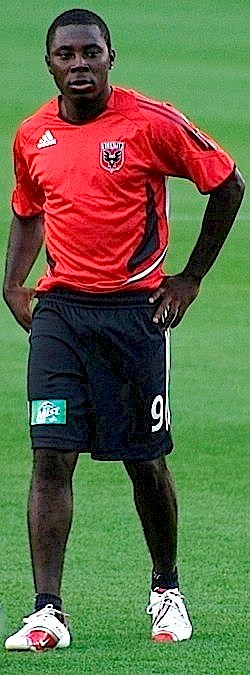NEWS RELEASE
AMERICAN ACADEMY OF ORTHOPAEDIC SURGEONS
************************* Adolescent sports injuries: Pain is not a gain! San Diego, February 16 - You know that adolescent sports have changed when a 13-year old soccer player named Freddy Adu signs a contract with Nike.
A year later, Adu [shown] became the highest-paid American pro soccer player raking in a cool $500,000 a year.
"Pediatric athletes are not little adults. They are still growing and developing - putting them at higher risk for serious injuries," said Mininder S. Kocher, MD, MPH, spokesperson for the American Academy of Orthopaedic Surgeons and associate director, Division of Sports Medicine, Children's Hospital, Boston, MA.
Serious injuries in young athletes are occurring at a higher rate and at a younger age.
Forty per cent of all emergency visits are for sports injuries in children age 5 to 14.
According to Dr. Kocher, it is not uncommon to see ACL (anterior cruciate ligament) injuries in 9- and 10-year-old children.
That type of injury can be a real challenge to the orthopaedic surgeon.
A child may need to have surgery but surgery can "cause growth plate disturbances" as well as other problems.
"Growth plates" are the area of developing tissues at the end of the "long bones" of the body.
Growth plates are also particularly vulnerable to injury in contact sports like football and basketball.
In the past, Dr. Kocher rarely saw patients entering high school that had already had shoulder injuries serious enough to require surgery.
Now most of the post-middle, junior high group he sees have had shoulder surgery.
What is termed "Little League elbow" is commonplace in the youngest patients.
Several studies have found a high incidence of chronic elbow and shoulder injuries in young pitchers.
Approximately 60 per cent of 11- to 18-year-olds have had an injury due to the repetitive motion and overuse of the elbow and shoulder.
Little to no attention is being paid to what type of pitches and throws a young player is being asked to make or the number s/he is making in a game or practice session.
These types of "overuse" injuries are also found with gymnasts. Coaches often lack the training to really understand the impact of these highly competitive sports on young bodies and how to help players avoid sports injuries.
In Europe, coaches receive medical training and certification is required.
Coaches in the United States do not need any training or licensing.
With coaches trying to win games along with parents who want successful children, the pressure on young athletes is intense and unrelenting.
There is a large gap between why parents want their children to play in sports and why the kids want to play.
Young people cite wanting to have fun as the number one reason they want to play sports followed by being with their friends.
Up to 70 per cent of all young athletes drop out of sports by the age of 14.
That statistic is a real concern for doctors who are worry about the growing incidence of obesity in adolescents.
A mentality of "no pain, no gain" among some coaches and parents also contributes to the increasing frequency of serious sports injuries.
Mininder S. Kocher, MD, MPH, encourages adults to seek medical help when children and adolescents experience pain. "Pain is a important signal that there could be a more serious problem. It shouldn't be ignored."
Dr. Kocher also cautions parents about their children only participating in one sport.
"I think kids are being forced to focus on a single sport at an earlier age as competitive intensity has ramped up. This may actually lead to an overuse injury."
Kocher encourages parents to: "Understand your child's goals when playing sports. Your child's goals could be very different than your own."
It is important to bring those two sets of expectations into line.
Proper training and equipment along with an understanding of the biomechanics of young people is critical to stemming the tide of serious injuries and surgeries.
The academy, in cooperation with the Pediatric Orthopaedic Society of North America (POSNA), sponsored a symposium on pediatric sports injuries at the AAOS annual meeting at the San Diego Convention Center.
*************************
